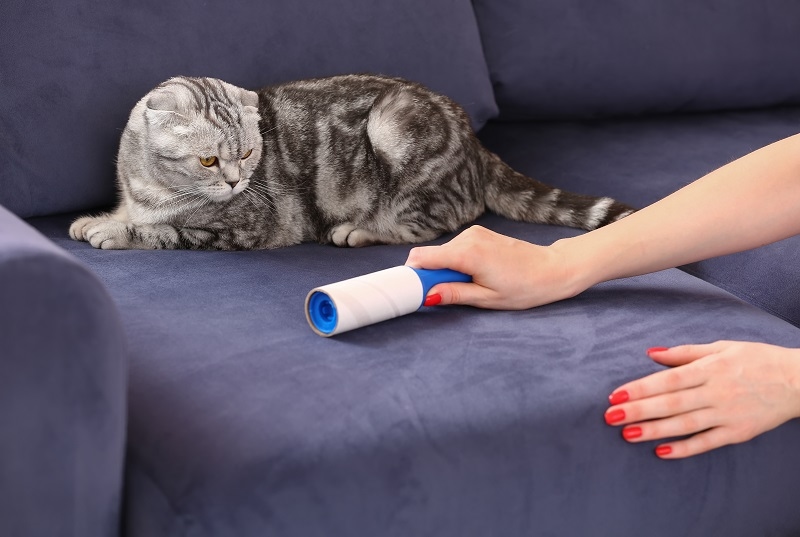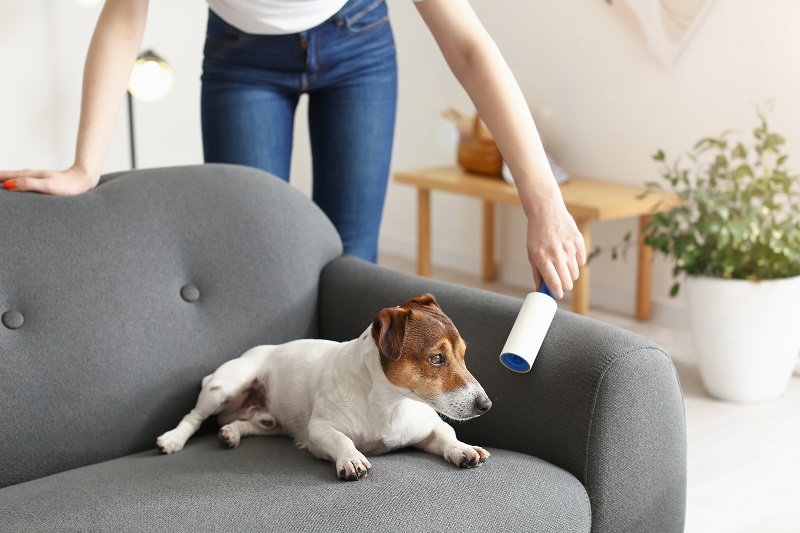
If you live with furry friends, you already know the struggle: regardless of how much you clean, pet hair ends up everywhere. Knowing how to remove pet hair from your furniture quickly will save time, protect your upholstery, and keep your home looking fresh and inviting. This ultimate guide features pet hair cleaning hacks and the best pet hair tools, providing everything you need to declutter your furniture of pet hair and keep it looking fresh.
Knowing how to remove pet hair from your furniture is not only crucial for maintaining a clean environment, but it also protects your investment and promotes a healthier home. Pet hair carries allergens, dirt, and dander that can decrease the quality of your indoor air quality and degrade the quality of fabric fibers over time. Whether it's a soft couch, a fabric chair, or a plush rug, regularly removing pet hair will help maintain the fabric quality and prolong the lifespan of your furniture.
If you or your family members suffer from allergies, properly removing animal hair from the couch (among other things) can significantly minimize the discomfort that's caused by pet-related allergens. Getting into this habit a few times a week can have a positive impact on the general condition of your home.
The task of removing pet hair from your furniture is much easier when you have access to the right tools. While some of the cleaning tools listed below have a higher upfront cost than others, each will save time and improve results. The following tools are the best practices for cleaning pet hair from upholstery and furniture:
You can do a lot of good with just a simple pair of rubber gloves. Slightly dampen them and rub them across the surface of the upholstery. The static electricity generated from the gloves attracts the pet hair, allowing you to clump it together and remove it with ease. This cleaning hack is an inexpensive and surprisingly effective way to get rid of your pet's hair.
Every day, maintenance of couch hair removal can be accomplished with lint rollers. Reusable lint rollers that come with adhesive sheets, and even the silicone-based ones, are environmentally friendly options, too.
Vacuum cleaners designed for pet owners typically come with pet-specific attachments. These vacuums excel at extracting hair and debris from fabric surfaces, thanks to their powerful and clumping attachments of varying types. Using these vacuum attachments is essential for cleaning pet fabric anywhere.
Soft-bristle upholstery brushes can help with the extraction of stubborn hair, especially fine or short hairs, without pulling the fragile fabric. An upholstery cleaner or mild fabric spray may also help to loosen embedded hair. A soft-bristle upholstery brush is required for almost every type of fabric cleaning that requires hair removal.
Sponge-like tools that are specifically designed for the removal of pet hair operate by attraction of the hair through friction. These tools work best on textured surfaces, such as corduroy or suede.
Before beginning to use your vacuum, take a dryer sheet and lightly rub it across the furniture. Its anti-static properties will help eliminate some of the static cling, making it easier to remove hair from furniture.
With these best pet hair tools in your cleaning toolkit, you can remove pet hair from any type of furniture.
Knowing how to remove pet hair from furniture is more than brushing it off the surface. When you refer to eliminating pet hair like a pro, it relates to a step-by-step expert process:
Use a handheld vacuum or lint roller to remove loose hair. Regardless of what you use, be sure to work in only one direction of the furniture to get as much hair up as possible.
Using a damp microfiber cloth or rubber gloves, gently wipe the furniture's surface. The hair will easily adhere to the wet surface.
Using your vacuum cleaner with a pet hair attachment, vacuum the furniture for deep cleaning of pet hair and dander.
A light spritz of anti-static fabric spray will help keep hair from reattaching after you clean it up. If you're cleaning fabric for pets, always use a non-toxic, pet-safe formula!
Once everything is dry, go over the area again with a pet hair cleaning brush or roller for a final pass. This will ensure you have gotten every last hair to your satisfaction.
When you make this a habit, it will keep your furniture looking clean and free of allergens that can be present in your home.

Even after cleaning your upholstered/specialty furniture for hair, your fabric can still be holding oils, dirt, and dander underneath. Regular fabric cleaning for pets helps prevent odors and keeps your upholstery fresh.
Having a strong vacuum with a HEPA filter can capture fine hair and allergens. Pay particular attention to seams, corners, and under cushions, where pet hair migrates in various pieces!
Steam cleaning uses very high temperatures to kill bacteria, while starting the process of de-shedding, versus simply cleaning up after your pet. Once a month can help with indoor air quality even in households without pets, and keep the upholstery fresh by dislodging embedded hair!
Don't use strong chemicals. Opt for pet-safe cleaners designed specifically for upholstery. They are safe for pets and humans and work great to remove hair on the couch and stains.
Buying washable furniture coatings can make life easier when cleaning. Incorporate them into your pet hair cleaning regimen by throwing them in the washing machine.
Preventing the buildup of shedding from your pets is just as important as cleaning. Here are some proven cleaning tips for pet owners to keep the shed hair on furniture to a minimum in cleaning your home.
Regularly grooming your pet can help reduce shedding and keep the pet's hair off your furniture. Use grooming tools according to your pet's coat type.
Establish pet-free areas on some furniture pieces. You will have to remove pet hairs from your couch much less frequently.
Good quality air purifiers can collect airborne hair and dander before it settles on your furniture.
Your pet's bed could be a significant source of hair.
Cleaning it weekly will reduce the spread of fur to other areas.
If you're contemplating purchasing new furniture, select cushions made of easy-to-clean materials, such as leather, microfiber, or synthetic blends. These materials typically resist static cling, making your routine of removing pet hair particularly easier.
With the addition of these habits, the cleaning tips for pet owners above will aid in keeping your home comfortable, clean, and welcoming.
If you favor a natural cleaning method or want to save some money, there are a variety of methods you can use to remove pet hair from pet furniture completely:
These simple, inexpensive methods are effective solutions to include in your homemade toolkit to clean pet hair.
It can be useful to have the important items to manage shedding. You may consider adding a few or all of the following tools to your toolkit:
Using these tools will help keep your pet's hair cleaned and protect your furniture.
Management. Instead of just addressing the issue, it is best to be proactive:
Going ahead prevents time, effort, and a clean environment.
Getting the hang of removing pet hair from furniture doesn't have to be a huge task. With regular care, it will become a way of life. Use the best pet hair removal products, try the unique tips for cleaning as a pet owner, and consistently clean your pets' fabrics to create a pleasant, clean environment for you and your pets.
Keeping your furniture clean is about finding a compromise between caring for your pets and protecting your home. With all these techniques and strategies to use, both you and your pets can coexist, with your pets remaining happy and healthy, making them wonderful companions.
This content was created by AI